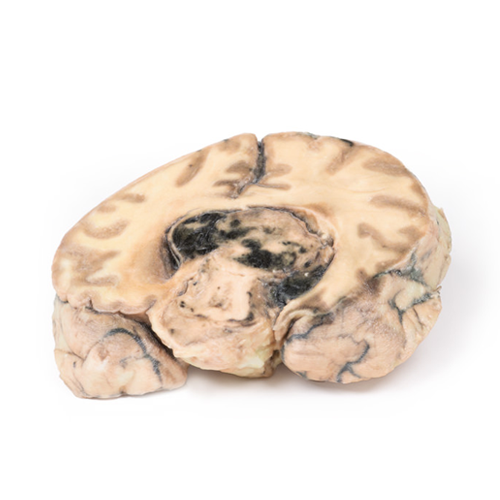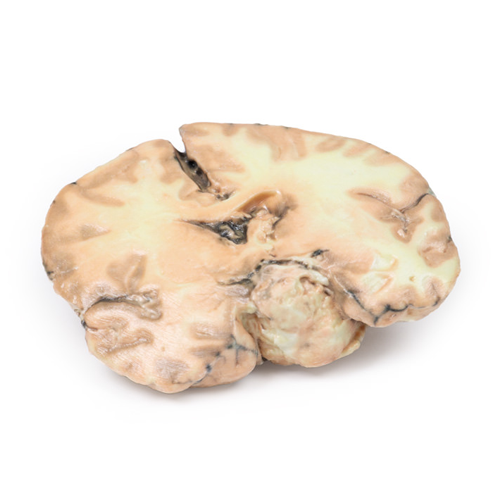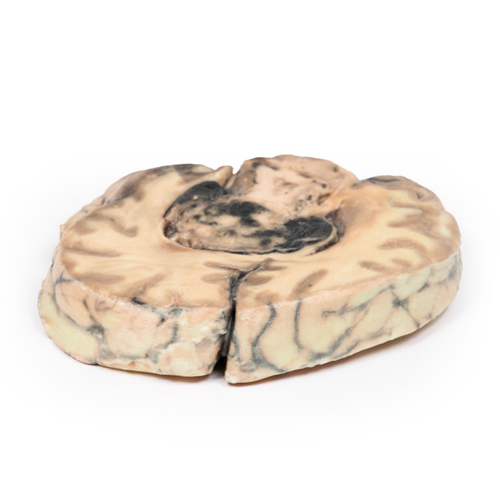| 13241-000 | 90,750 (税別82,500)円 |
|---|
- 病理模型
- 頭部
- 血管
- 3Dプリント
EZ-242



| 13241-000 | 90,750 (税別82,500)円 |
|---|
| 特長 | 56 歳男性。全身性発作の後死亡した。6ヶ月前より精神錯乱、短期記憶喪失、性格の変化があったことが明らかになりました。 Product information "Glioblastoma multiforme" Clinical History A 56-year old male presented with a generalised seizure. He remained unconscious after this seizure and later died. A collateral history revealed 6 months of progressive confusion, short-term memory loss and personality change. Pathology Coronal sections of the brain post mortem show a 4cm necrotic and haemorrhagic tumour. Tumour invasion from the inferior frontal lobe into the lateral ventricle is apparent. Meningeal spread is evident on examination of the posterior aspect of the specimen. Further Information Gliomas are the second most common cancer of the central nervous system after meningiomas. The term “glioma” refers to tumours that are histologically similar to normal glial cells i.e. astrocytes, oligodendrocytes and ependymal cells. They arise from a progenitor cell that differentiates down one of the cell lines. Glioblastoma multiforme (GBM; also called glioblastoma) develop from the astrocyte lineage. GBMs can arise in the brain “de novo” or evolve from lower-grade astrocytomas or oligodendrogliomas. GBM is often referred to as a grade IV astrocytoma. They are differentiated histologically from anaplastic astrocytomas by necrotising tissue surrounded by anaplastic cells as well as by the presence of hyperplastic blood vessels. GBMs are more common in males. It is most commonly diagnosed in the 6th decade of life. Genetic risk factors include neurofibromatosis type 1 and Li-Fraumeni syndrome. Previous brain radiotherapy is also associated with increased risk of GBM. Symptoms vary depending on the location of the GBM, but may include any of the following: • Persistent headaches • Double or blurred vision • Vomitng • Loss of appetite • Changes in mood and personality • Changes in ability to think and learn • New onset of seizures • Speech difficulty of gradual onset Diagnostic tools include computed tomography (CT scan) and magnetic resonance imaging (MRI). Around 50% of these tumours occupy more than one cerebral hemisphere. GBMs commonly extend into the ventricular walls or meninges, and thus into the central spinal fluid (CSF). Spinal cord spread is uncommon. Metastasis beyond the central nervous system is rare. Tumour growth causes cerebral oedema leading to increased intra-cranial pressure. These are biologically aggressive tumours, and if left untreated survival is typically 3 months. The mainstay of treatment for GBMs is surgery, followed by radiation and chemotherapy. |
|---|---|
| 仕様 | エルラージマー社製 |
| 消耗品購入 | |
| 備考 | メーカー品番:MP2016 Erler-Zimmer GmbH & Co.KG の模型製品は、日本国内において株式会社京都科学の独占販売製品です。 |
| 医療機器クラス分類 | なし |
| 特定保守管理医療機器 | 該当なし |
| JANコード | なし |
| 更新年月日 | 2020年06月16日 |